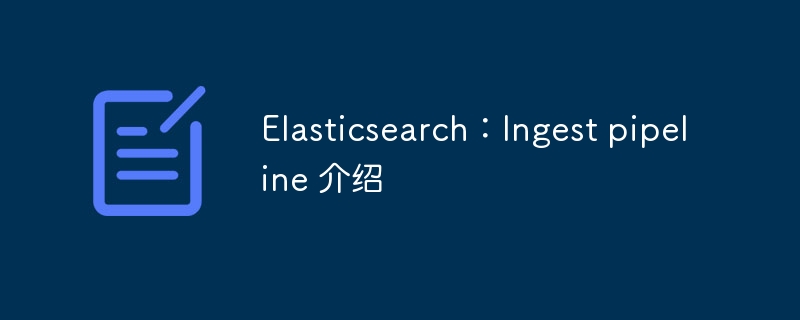Home >Technology peripherals >AI >Elasticsearch:Ingest pipeline 介绍
Elasticsearch:Ingest pipeline 介绍
- DDDOriginal
- 2024-08-13 15:18:23716browse
Elasticsearch ingest pipelines empower users to transform, validate, enrich, filter, and modify data before indexing. By utilizing various processors, these pipelines enhance data quality, improve search results, and drive business value. Key benefit

Elasticsearch: Ingest Pipeline Introduction
Ingest pipelines in Elasticsearch empower users to enrich, filter, or modify data before indexing it. By utilizing a series of processors, these pipelines unlock transformative capabilities that enhance data quality, improve search results, and drive business value.
What are the key benefits of using ingest pipelines in Elasticsearch?
Ingest pipelines offer several distinct advantages:
- Data transformation: Seamlessly transform incoming raw data into the desired format, structure, or encoding.
- Data validation: Enforce data integrity by validating incoming data against predefined rules or schemas.
- Data enrichment: Enhance data by extracting additional insights, such as enriching product catalogs with pricing information or associating order logs with user profiles.
- Data filtering: Exclude unwanted or redundant data before indexing, optimizing search results and reducing storage requirements.
- Centralized processing: Consolidate data processing tasks within Elasticsearch, eliminating the need for complex external pipelines.
How can I create and configure an ingest pipeline in Elasticsearch?
Creating and configuring an ingest pipeline in Elasticsearch involves the following steps:
- Define the pipeline: Create a new pipeline by specifying its unique identifier, followed by the specific processors to be applied.
- Select processors: Choose from various available processors, each performing a distinct data manipulation or filtering task.
- Configure processors: Customize each processor's parameters, such as the field mappings, extraction patterns, or validation rules.
- Associate the pipeline: Attach the ingest pipeline to a specific index, ensuring that all data indexed into that index undergoes the pipeline's transformations.
What are the different processors available for use in ingest pipelines?
Elasticsearch provides an extensive library of processors that cater to diverse data processing needs:
- Conversion processors: Convert data between different formats, such as converting timestamps or strings to numbers.
- Extraction processors: Extract structured data from semi-structured or unstructured documents, such as parsing addresses from free-form text.
- Enrichment processors: Enhance data by adding additional fields, such as appending a customer's location based on their IP address.
- Filtering processors: Remove or modify data based on predefined conditions, such as filtering out documents with missing or invalid data.
- Grok processors: Leverage the Grok pattern language to extract complex structures, such as email addresses or log messages.
The above is the detailed content of Elasticsearch:Ingest pipeline 介绍. For more information, please follow other related articles on the PHP Chinese website!
Related articles
See more- OpenAI co-founder interviewed by Huang Renxun: GPT-4's reasoning capabilities have not yet reached expectations
- Reinforcement learning is on the cover of Nature again, and the new paradigm of autonomous driving safety verification significantly reduces test mileage
- When GPT-4 learns to read pictures and texts, a productivity revolution is unstoppable
- AI helps Microsoft compete with Google in search business: Bing visits increase by 15.8%
- To make up for the shortcomings of Stanford's 7 billion parameter 'Alpaca', a large model proficient in Chinese is here and has been open source

